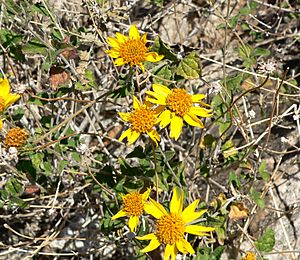Bahiopsis parishii facts for kids
Quick facts for kids Bahiopsis parishii |
|
|---|---|
 |
|
| Scientific classification | |
| Kingdom: | |
| (unranked): | |
| (unranked): | |
| (unranked): | |
| Order: | |
| Family: | |
| Genus: |
Bahiopsis
|
| Species: |
B. parishii
|
| Binomial name | |
| Bahiopsis parishii (Greene) E.E.Schill. & Panero
|
|
| Synonyms | |
|
|
Bahiopsis parishii, also known as the Parish goldeneye or shrubby goldeneye, is a beautiful flowering shrub found in North America. It belongs to the sunflower family, which is called Asteraceae.
This plant grows naturally in the southwestern parts of the United States. You can find it in southern California, southern Nevada, Arizona, and southwestern New Mexico. It also grows in nearby areas of northwest Mexico, like Baja California, Baja California Sur, and Sonora.
What Does It Look Like?
The Parish goldeneye usually grows up to about 2 feet (60 centimeters) tall. It has bright yellow flowers that look a bit like small sunflowers.
This plant loves living in desert areas. You'll often find it growing near a plant called the creosote bush. It can grow from sea level all the way up to about 5,000 feet (1,500 meters) high!
The Parish goldeneye blooms after it rains. This can happen in the spring or fall. In Arizona, it often blooms after the summer monsoon season, when there's a lot of rain.
Who Was Parish?
The name Bahiopsis parishii honors two brothers, Samuel Bonsall Parish and William Fletcher Parish. They were both very active botanists, which means they studied plants, in southern California. They lived in the late 1800s and early 1900s.
This plant is very similar to another plant called Bahiopsis deltoidea. Sometimes, people even consider them to be different types of the same plant.

